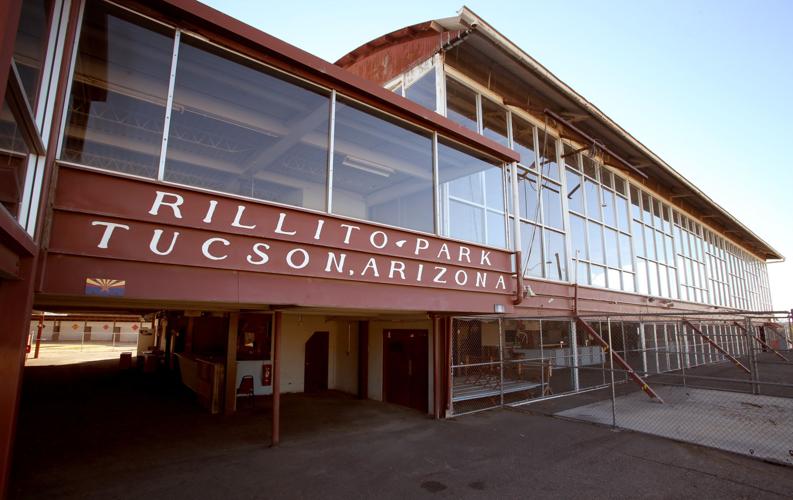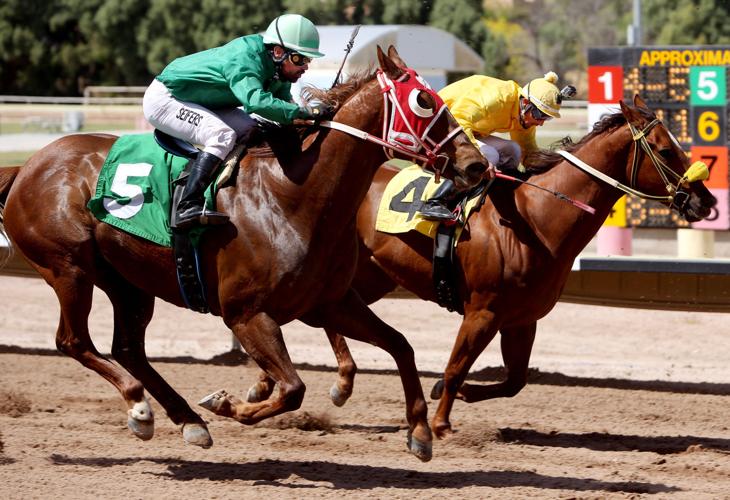On Tuesday, the Pima County Board of Supervisors will face a simple question about the complicated, long-simmering and divisive issue of horse racing at Rillito Park: should it stay, or should it go?
The specific matter will be a four-year extension of the current lease with Rillito Racing Inc., which manages the sport and related business at the facility.
However, without that extension, County Administrator Chuck Huckelberry recommends “funding the demolition of the grandstand to reduce the county’s risk associated with its current condition.” That would cost an estimated $400,000.
“If we don’t extend the lease, I think it’s the end of horse racing at Rillito,” said Supervisor Sharon Bronson, whose district includes the park.
A $1 million donation from the Bert W. Martin Foundation also hangs in the balance. Without an extension approval before the end of January, the offer, which would be used for a number of needed repairs to the grandstand, clubhouse and other facilities, will be rescinded. A list of over $2 million in repairs is included in the contract amendment the supervisors will consider Tuesday morning.
The racing facility is recognized as “the birthplace of quarter-horse racing in the United States,” and races have regularly been held at the site since the 1940s, though some dispute its historical significance.
Jaye Wells, president of the Rillito Park Foundation, of which Rillito Racing is a part, said that without a multiyear lease extension, getting donations from the Martin Foundation and other organizations would be extremely difficult. All improvements to the grandstand and other horse-racing infrastructure are the responsibility of the racing lessee, not the county.
Approval of the lease would essentially cement the park’s status quo through June 2021, and that status quo has not been without tension. In addition to being the site of some of the country’s earliest quarter-horse racing, Rillito, with 11 full-size soccer fields, is the county’s largest soccer facility, and scheduling conflicts have arisen between the different users. Rillito is also used by the weekly Heirloom Farmers Market and special events like the annual Tucson Celtic Festival, held in early November.
Some in the youth soccer community would like to see Rillito’s space be used to fit as many soccer fields as possible, which would require the costly relocation of horse racing facilities, and they point to county’s growing population and rising scarcity of sports fields.
Ted Schmidt, president of the Pima County Junior Soccer League, the umbrella organization for regional youth soccer, argues that was also the Board of Supervisors’ unanimous preference in 2006.
The soccer league holds many of its weekend games at Rillito and the Tucson Soccer Academy, of which Schmidt is also president, and is the primary user of the facility for weekday practices.
In August 2006, the Board of Supervisors approved a resolution calling for horse racing to be moved to another location and a complex with 18 soccer fields to be built, according to a recently completed 14-page county report on the park, which, with supporting documentation, stretches past 700 pages.
However, the Great Recession hit county finances hard shortly after and delayed a proposed 2008 bond package, which could have provided funds for the costly recommendations, until 2015. Voters that year overwhelmingly shot the proposal down.
“I think it’s unfortunate that both for economic and political reasons we didn’t move forward in 2006 with the plan that we had,” Schmidt said, adding later that he “understands the reality of the economics right now, that we can’t move the racetrack.”
Nanette Slusser, an assistant county administrator, told most parties with a stake in Rillito at a Dec. 22 meeting that clearing the park and putting in up to four additional fields — the most she and other officials say could fit without compromising parking capacity — would cost about $8 million.
“We don’t have $8 million,” she said, adding that another bond package would be the only way to get that kind of cash for park expansion.
“The likelihood of doing a bond package in the next three years … is slim to none,” Bronson, who helped facilitate the sometimes tense meeting, said, adding that roads would be the most likely priority of any conceivable bond program.
That’s part of why Schmidt isn’t necessarily opposed to the supervisors approving the four-year lease extension. But what he’s hoping to get from them is acknowledgment “that the long- term plan for Rillito needs to be the conversion of that property into a sports complex” and eventually moving horse racing to “a suitable location.”
County officials, including Slusser, say there aren’t any clear alternative sites, and two promising prospects fell through since 2006. Schmidt, however, disagrees, and said someplace like the Desert Diamond Casino could work.
Schmidt believes that with sufficient investment, Rillito could become a major interstate and regional soccer tournament site, which could have multimillion-dollar economic impacts for the county. Data cited in the county report shows that an 18-field facility in Phoenix, Reach 11, has an annual economic impact of $152 million. A 2015 study commissioned by the only other Arizona racetrack operator Turf Paradise found the sport’s statewide annual economic impact is around $91 million.
Officials have a dimmer view of Rillito’s soccer tournament prospects, and the report concludes that the park, even with more fields, “is inadequate to support soccer tournament activity beyond local and smaller regional events.”
The county hopes to develop 162 acres south of the Kino Sports Complex, on Tucson’s southeast side, into a major tournament site with 20 fields. Slusser said that project is estimated to cost $55 million, some funding for which was included in the failed 2015 bond package.
Beyond renewed commitment by the supervisors to the 2006 resolution, Schmidt said he’d like some “accommodations” from the county in exchange for support for the lease extension of the racetrack.
Those include new lights for two unlit fields, affordable access to Kino Sports Complex fields when there are conflicts between racing and soccer, and a passage between the four fields on the inside of the track to the park’s seven other fields. Slusser estimated the costs for some of those improvements would be around $325,000.
Bronson said she supports some of those measures, saying there are “some small things we can do.”
But if things go according to plan, Wells sees the future of racing extending well beyond the end of the next lease. He said the business of horse racing “has been growing like crazy,” and recent attendance figures show there’s still interest in the sport.
There were nearly 39,000 paid attendees for the 2015 racing season, and over 27,000 the next year, but because there were fewer racing days 2016 actually had a higher average daily attendance. Daily average betting rose from $71,000 to $103,000 between 2014 and 2016. The racing season typically is held from late winter to early spring, with around 20 days of racing.
If the lease is extended, Slusser said it would provide horse racing with a “do or die” opportunity.
“At five years, they should be self-sufficient, or they will be gone,” she added.
Schmidt disputes the significance of local horse racing, and says interest in the sport is waning and that its business model, which relies heavily on alcohol sales and betting, is not appropriate at a park like Rillito. Youth sports and their numerous health benefits, on the other hand, are, he said.
Huckelberry said the county has an obligation to preserve the history and culture of Southern Arizona, adding later: “Yes, people can serve value judgments, but (horse racing) is still part of the culture and history.”
Racing also accounted for just over 40 percent of the $116,000 in revenues taken in by the county from facility users, according to the report. Youth sports, which includes soccer but also lacrosse, football and other sports, paid nearly $20,000 for using the facility’s lights. The county parks and recreation department spends about $300,000 annually on Rillito in maintenance and other costs, according to recent county budgets.
Providing recreation opportunities to local youth shouldn’t be about generating revenue, Schmidt said, echoing Slusser’s point that it is a “public service.”
Bronson told the Star she is likely to support a lease extension, though she conceded she is “conflicted” about the matter. Representatives from the farmers market and Celtic Festival, along with a number of students from the University of Arizona’s Race Track Industry Program also submitted letters in support of extending the lease.
“I think at this point the status quo is the best we can do,” Bronson said, referencing the financial obstacles to expanding the park or moving the racetrack.
“Over the next five years, I think horse racing has a place in this community, as does soccer” she added. “I think they need to coexist.”
While Schmidt sees horse racing as an obstacle to his vision for the park, he said farmers markets and other special events are not.
In his memo about the lease extension, Huckelberry suggested some ways to promote coexistence: better coordination between the park’s users, and centralization of horse-race and tournament scheduling with the county parks and recreation department, whose “master-use calendar” is a good way to “minimize conflicting use dates.”
His other suggestion, that the number of annual race days be capped at 16 unless the supervisors approve additional days, didn’t go over so with Wells, who said such a measure would “bottle up our potential.”
But whatever arrangement the supervisors approve on Tuesday — if they approve one at all — Wells said that if horse racing is “given a chance to succeed … it puts the odds in our favor.”





